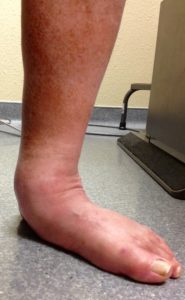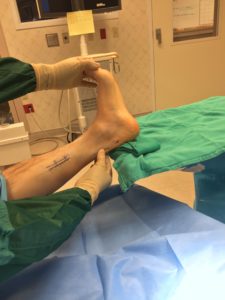When I feel an unusual pain or twinge in my ankle, I tend to ice it and figure I’ll be fine in the morning. And sometimes, the pain is gone. But then it comes back. Dr. Michael Dujela of Washington Orthopaedic Center, with locations in Olympia and Centralia, is a board certified, orthopaedic-fellowship-trained foot and ankle surgeon. After speaking with him, I will never ignore that twinge in my ankle again.

Dr. Dujela is involved nationally and internationally as a surgical educator and skilled foot an ankle surgeon. He serves as national chairman of the Education and Scientific Affairs Committee for the American College of Foot and Ankle Surgeons, the world’s largest organization of foot and ankle surgeons who designs national courses and material in the field. He is a peer reviewer for the Journal of Foot and Ankle Surgery and frequently lectures and teaches techniques and implementation of cutting edge technologies throughout the world. Dr. Dujela knows the foot and ankle, that much is clear.
“Tendonitis is inflammation that develops essentially because of overuse, inappropriate training techniques or misalignment of the way a foot is naturally,” explains Dujela. “Often, at first, the pain comes and goes so many people don’t recognize they have it or they ignore it.”
He shares the several different types of tendonitis Washington Orthopaedic routinely sees and treats below.
Posterior Tibial Tendonitis

This type of tendonitis occurs when the posterior tibial tendon – that’s the one on the inside of the ankle that travels from the leg to the side of the foot – becomes inflamed. Dujela says this type of tendinitis happens more typically in older people who may carry a bit of extra weight or have a flatter foot.
“We tend to see people develop a flat foot over time as the tendon deteriorates,” Dujela explains. “Left untreated, the tendon becomes more and more diseased and they develop elongation and tearing of the tendon. Their arch collapses as this happens.” At that point, Dujela adds, patients can develop arthritis in addition to the tendonitis.
Having trained with some of the world’s leading orthopedic surgeons, Dujela has treated thousands of tendonitis cases. The worst thing, he says, is when people don’t get it treated early. It goes from being something that could have been solved with an insert, to someone needing a brace or a complex surgical correction.
Achilles Tendonitis
The Achilles tendon can get inflamed and begin to deteriorate if left untreated. Insertional disease happens where the tendon attaches to the heel bone. People who suffer from this are often overweight and/or overuse the tendon. They are not commonly athletes. They usually have a less flexible tendon and chronic tightness in the calf muscle. Inflammation can also happen 4-6 cm above the heel in the tendon itself. This is usually seen in athletes.
Dujela explains that we have diminished blood flow in the area above the heel, so the body it not able to adequately heal. This is another reason why it’s important to have any Achilles pain checked.

“People will go from an early tendonitis situation that, left unchecked, will develop into tendinosis, which is actually a degenerative issue, Dujela explains. The biggest sign is the development of a hard, moderate-sized lump on the tendon. “That places them at increased risk of rupture, which really only happens when there is pre-existing disease.”
Now you’ve gone from a simple, non-surgical correction, to a complex surgery with months of recovery time. “It’s not that we can’t fix it, we fix them every day. But, it’s easier on you if you don’t have to go through surgery,” he says. Treatments can include a change of activity, a temporary heel lift, physical therapy and eccentric modalities (controlled strain that tricks the body into healing).
Dujela says many patients who have ruptured their tendon describe it as if they “got hit on the back of the leg.” If you already have a nodule on your tendon, treatments include scraping techniques through physical therapy, immobilization and potentially surgery.
Peroneal Tendonitis
Peroneal tendonitis is inflammation of the peroneal tendon that runs on the outside of the ankle. People with poor heel position that walk more to the outside of their foot (foot tilts as they walk) are more susceptible to this type of tendonitis because the peroneal tendons are working harder than it should be with each step.
“In some cases, people who have developed reoccurring ankle sprains or instability and chronic tendonitis, can develop split tears,” Dujela says. This is where the tendon tears lengthwise. Tears can be caused by over use, chronic tendonitis left untreated or a traumatic injury.”

Once there is a tear, treatment often involves surgery if they fail to improve with non operative care. Surgeries for all types of tendonitis are complex, and usually involve cleaning up the tendon, tendon transfers where they reroute or transfer your other tendons to compensate for the torn or degenerated one, and fixing any alignment issues. Dujela recently performed a surgery where he had to split the heel bone in half to correct the foot shape in addition to transferring tendons. He fixes alignment issues almost daily in surgery.
Dujela adds that they do not typically give cortisone injections around the tendon as he has seen it cause ruptures.
General Symptoms
Common symptoms of all ankle tendonitis include aching, swelling and difficulty walking. “Weekend warriors set themselves up for injuries such as tendonitis because they do not exercise all week, and then go out on Saturday and do a 26-mile walk,” he adds.
The best way to avoid this is to make sure you are working out properly, wearing the right shoe and insert for your foot type and are stretching properly. Having a trainer to work with is a great way to ensure you are doing things correctly and not over-using your tendons, as well. Above all, if you feel pain, stop and make a doctor’s appointment.
For more information or to schedule an appointment at their Olympia or Centralia office, visit the Washington Orthopaedic Center website or call 800-342-0205.


















































